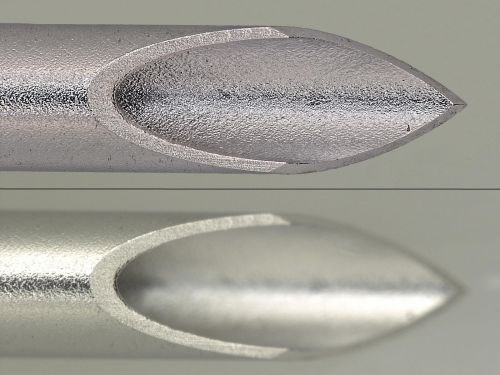Get Focused
Microscopes offer the magnification necessary to inspect small parts, but the in-focus viewing field can be limited. A digital microscope with autofocusing capabilities can simplify inspection by creating composite images that show the entire selected field in focus at once.
Share






Microscopes offer the magnification necessary to inspect small parts, but the in-focus viewing field can be limited. A digital microscope with autofocusing capabilities can simplify inspection by creating composite images that show the entire selected field in focus at once.
Operating an inspection microscope can be similar to taking a photo with manual focus. Like a photographer, the inspector must position the subject, check lighting, manage variables such as exposure and shutter speed, and adjust the zoom and focus of the lens to bring the feature of interest into view. However, while a photographer may purposefully create an image with blurred edges, shallow depth of field or other effects, industrial measurement and inspection tasks require clear, focused images. Inspecting all pieces of a part can mean repeatedly moving the part and readjusting the microscope to view all the detail necessary.
It is possible to automate steps in this process, however. For example the VHX-5000 digital inspection microscope from Keyence features auto-focusing capabilities to help take some of the time and difficulty out of capturing clear images for inspection purposes. Once a user moves the microscope to the desired viewing area on a given part, the VHX automatically scans through its focal range and quickly compiles a high-resolution composite image that shows all of the specified area in focus on the system’s screen. According to the company, the microscope’s high-frame-rate camera (offering 50 frames per second) can generate fully focused images in as little as one second.
In addition to saving time, the microscope also reduces the learning curve for operators. An Easy mode walks users through each function of the microscope to ensure its capacity is fully utilized, and, according to Keyence, improve the overall results obtained. Additionally, the microscope’s large depth of field, tilting arm and stage, and 0.1× to 5,000× magnification enable both 2D and 3D inspection.
Related Content
-
The Many Ways of Measuring Thickness
While it may seem to be a straightforward check, there are many approaches to measuring thickness that are determined by the requirements of the part.
-
How to Calibrate Gages and Certify Calibration Programs
Tips for establishing and maintaining a regular gage calibration program.
-
The Link Between CNC Process Control and Powertrain Warranties
Ever since inventing the touch-trigger probe in 1972, Sir David McMurtry and his company Renishaw have been focused on achieving process control over its own manufacturing operations. That journey has had sweeping consequences for manufacturing at large.

.jpg;width=70;height=70;mode=crop)

















.jpg;maxWidth=300;quality=90)

